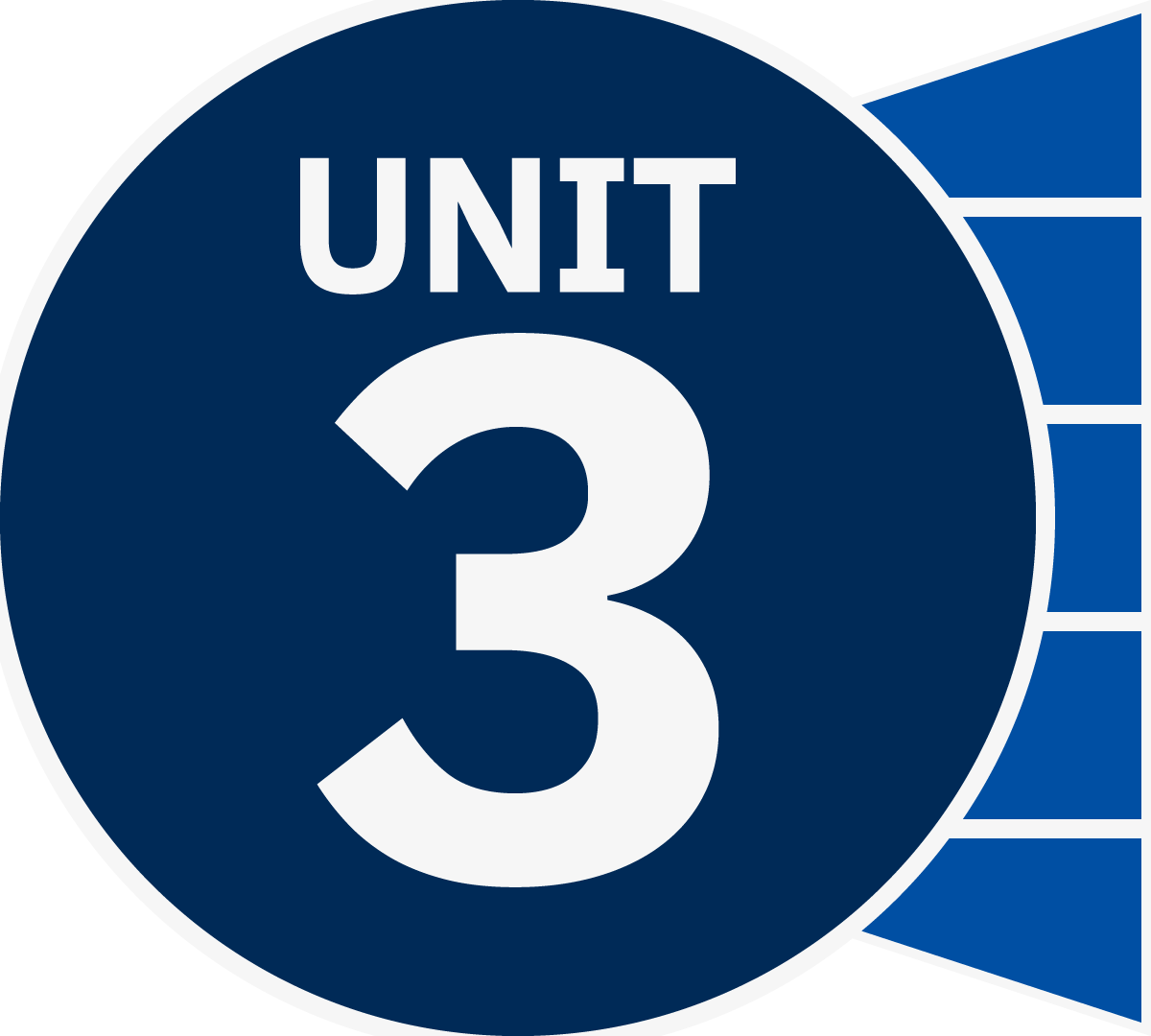Inquiry Companion: Unit 3
In Unit 3 of the We the People: The Citizen & the Constitution textbook, students discover the ways in which our Constitution is a living document that continues to evolve by examining the power of judicial review, the evolution of voting rights, and the impact of the Equal Protection Clause over the course of history.
How is the Inquiry Companion Structured?
Unit 3 challenges students to investigate the successes and failures of our democratic experiment. Our Inquiry Companion Guide activities for Unit 3 facilitate student participation in inquiry-based civics learning for each strategy.
Students engage by discussing a 1965 literacy test, and they explore the formation and function of political parties. They will explain the evolution of the Equal Protection Clause by participating in a civic conversation. Students then elaborate on voting rights and voter suppression through a democratic experience simulation. Finally, students will evaluate their understanding of the controversy surrounding judicial review.
Best practices for culturally responsive teaching weave through each activity.
Inquiry Guide Activity
Pique students’ interest and get them personally involved in the lesson by accessing prior knowledge and generating interest. Engage students’ curiosity in the compelling question.
In this lesson, students will access prior knowledge to complete a literacy test originally used to limit voting rights. They will discuss their reactions to the literacy test and the value of a vote.
Utilize this Engage strategy activity in order to enhance students’ understanding of Level 3, Unit 3, Lesson 17 and Lesson 20 or Level 2, Unit 5, Lesson 25.
We the People: The Citizen & the Constitution (Level 3)
- Unit 3, Lesson 17: How Did the Civil War Test and Transform the American Constitutional System?
- Unit 3, Lesson 20: How Has the Right to Vote Been Expanded Since the Adoption of the Constitution?
- Unit 5, Lesson 25: How Has the Right to Vote Expanded Since the Constitution Was Adopted?
- Active learning
- Attentiveness to political matters
- Equality and fairness
- Respect for others
- Social responsibility
- Identify the importance of voting
- Investigate how literacy tests were used to limit voting
- Evaluate reasons why some voters were disenfranchised
- Use the Exit Ticket to answer our inquiry question: “What is a vote worth?”
- What is a vote worth?
- civil rights Fundamental rights belonging to every member of a society.
- enfranchise Giving the right to vote to a person or category of persons.
- disenfranchise To deprive of the right to vote.
- Jim Crow laws Laws common in the South from 1877 until the 1950s that required African Americans to use separate schools and other public facilities and that prevented them from exercising the right to vote.
- literacy test A test that requires people to prove that they are able to read and write. Until 1964, these tests were used in various states throughout the country to keep minorities from voting.
- poll tax A tax that voters in many states were required to pay in order to exercise their right to vote. These barriers were used until 1964 to prevent African Americans from voting.
- suffrage The right to vote.
- Voting Rights Act (1965) This act further protected the right to vote for all U.S. citizens. It forced states to obey the Constitution. It made it clear that the right to vote could not be denied because of a person’s skin color or race.
Note: This lesson contains material about racism, inequality, poverty, and injustice that some students might find offensive or potentially traumatizing. This material has been included in order to provide students with historical knowledge of access to the vote in America. A culturally responsive classroom will provide a welcoming and safe environment where students feel comfortable discussing difficult topics. Ensure students feel comfortable sharing appropriate personal perspectives. Consider establishing classroom norms that encourage discussion.
The Framers left much of the voting requirements up to the states due to the fear of uninformed voters, the size of the country, and the accommodation of states’ rights. There is no accommodation for universal suffrage in the Constitution, and therefore, the right to vote has expanded and contracted over time.
During the Jim Crow era, Southern states employed literacy tests and poll taxes as a discriminatory tool to disenfranchise African American voters. Although these tests seemed to only assess skills in reading and writing, literacy tests were often intentionally complex and subjective, serving as a discriminatory barrier to voting. The Voting Rights Act of 1965 sought to dismantle such barriers, prohibiting literacy tests and other forms of discrimination at the ballot box. Despite these legislative actions, even today, voting-access debates persist, reflecting ongoing challenges to full participation in the democratic process.
Additional resources for teacher background include the following:
In this lesson, students will investigate tools that were used in order to disenfranchise voters by examining a literacy test. Teachers should preview all student materials and resources prior to the lesson.
- Welcome students to social studies.
- Introduce the inquiry question: “What is a vote worth?”
- Allow students time to make a prediction about the inquiry question as well as offer their own supporting questions.
- Using your routine strategy for setting up groups, divide the class into five collaborative groups.
- Tell students that they will test their own constitutional knowledge to see whether they would be eligible voters in 1965 Alabama.
- Distribute one Literacy Test Team Card to each team.
- Tell students they have 5–7 minutes to collaborate and answer the questions without using the internet, textbooks, or other outside resources. This is a contest of current knowledge. Teams must unanimously agree on the answers.
- Circulate around the room, encouraging each group, observing progress, and redirecting as needed.
- Return to a full class format and use the Literacy Test Answer Key to reveal correct answers. Consider a trade-and-grade format or go over the answers as a class.
- Facilitate a class discussion by asking the following questions:
- Based on the results of this 1965 Alabama Literacy Test, who in this class would be eligible to vote?
- How do you feel about this process?
- What did you think or feel while taking the test?
- Did you finish on time?
- What questions did you find easy or difficult?
- Why was it frustrating/aggravating/condescending?
- Do you think that the test was designed for failure?
- What do you think was the intent of the test design?
- Why would someone want to design a test that was intended to make people fail?
- Should individuals be required to have some civic knowledge in order to vote?
- Who gets to decide what knowledge is a prerequisite to voting?
- What other ways are people disenfranchised?
- What is the value of a vote?
- Conclude the lesson by explaining the following:
- After the passage of the Civil War amendments, in addition to literacy tests, many states required a poll tax to be paid in order to vote. The cost of the poll tax was often a challenge for many to afford and therefore was another strategy to disenfranchise voters, particularly African American voters.
- The ratification of the 24th Amendment in 1964 ended poll taxes across the nation.
- The passage of the Voting Rights Act in August 1965 outlawed the discriminatory voting practices adopted in many southern states after the Civil War, including literacy tests, as a prerequisite to voting.
- However, neither the Constitution nor any of the amendments provide for universal suffrage.
Students will demonstrate mastery of disenfranchisement strategies by completing the Exit Ticket in order to answer our inquiry question: “What is a vote worth?”
Students may attempt the entire 1965 Alabama Literacy Test or explore literacy tests from other states.













